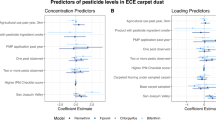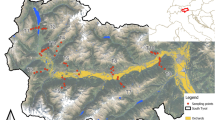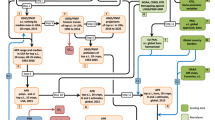Abstract
The Columbia Center for Children's Environmental Health (CCCEH) previously reported widespread residential insecticide use in urban communities in New York City. Research suggests that pyrethroids are replacing organophosphates (OPs) in response to 2000–2001 US EPA pesticide regulations restricting OP use. A systematic assessment of active ingredients used for residential pest control is lacking. We queried a database of pesticide applications reported by licensed applicators between 1999 and 2005 and surveyed pest control products available in 145 stores within 29 zip codes in the CCCEH catchment area including Northern Manhattan and the South Bronx. Pyrethroids, pyrethrins, piperonyl butoxide, and hydramethylnon were the most common insecticide active ingredients reported as used by licensed pesticide applicators within the 29 zip codes of the CCCEH catchment area between 1999 and 2005. Use of certain pyrethroids and some non-spray insecticides such as fipronil and boric acid increased significantly by year (logistic regression, OR>1.0, P<0.05), whereas use of OPs, including chlorpyrifos and diazinon decreased significantly by year (logistic regression, OR<1.0, P<0.05). Among pesticide applicators, the most commonly applied active ingredients were formulated as spray applications. With 145 stores in the catchment area, 120 (82.5%) carried at least one insecticide. Spray cans were most common (114/120 stores, 95%); gels were least common (31/120 stores, 25.8%). Among spray formulations, pyrethroid insecticides were the most common pesticide class and permethrin, a pyrethroid, was the most common individual active ingredient. In 2007, one store carried a product containing chlorpyrifos and one store carried a product containing diazinon. This survey suggests that certain pyrethroids and non-spray insecticides replaced OPs for pest control in this area. Chlorpyrifos and diazinon have nearly been eliminated from products marketed for residential pest control.
This is a preview of subscription content, access via your institution
Access options
Subscribe to this journal
Receive 6 print issues and online access
$259.00 per year
only $43.17 per issue
Buy this article
- Purchase on Springer Link
- Instant access to full article PDF
Prices may be subject to local taxes which are calculated during checkout




Similar content being viewed by others
Abbreviations
- ANOVA:
-
analysis of variance
- CAB:
-
Community Advisory Board
- CCCEH:
-
Columbia Center for Children's Environmental Health
- DEC:
-
Department of Environmental Conservation
- NYCDOHMH:
-
New York City Department of Health and Mental Hygiene
- OR:
-
odds ratio
- PSUR:
-
Pesticide Sales and Use Reporting
- US EPA:
-
United States Environmental Protection Agency
- WE ACT:
-
West Harlem Environmental Action
References
Adgate J.L., Kukowski A., Stroebel C., Shubat P.J., Morrell S., and Quackenboss J.J., et al. Pesticide storage and use patterns in Minnesota households with children. J Expo Anal Environ Epidemiol 2000: 10 (2): 159–167.
Bekarian N., Payne-Sturges D., Edmondson S., Chism B., and Woodruff T.J. Use of point-of-sale data to track usage patterns of residential pesticides: methodology development. Environ Health 2006: 5: 15.
Berkowitz G.S., Obel J., Deych E., Lapinski R., Godbold J., and Liu Z., et al. Exposure to indoor pesticides during pregnancy in a multiethnic, urban cohort. Environ Health Perspect 2003: 111 (1): 79–84.
Berkowitz G.S., Wetmur J.G., Birman-Deych E., Obel J., Lapinski R.H., and Godbold J.H., et al. In utero pesticide exposure, maternal paraoxonase activity, and head circumference. Environ Health Perspect 2004: 112 (3): 388–391.
Carlton E.J., Moats H.L., Feinberg M., Shepard P., Garfinkel R., and Whyatt R., et al. Pesticide sales in low-income, minority neighborhoods. J Community Health 2004: 29 (3): 231–244.
Davis J.R., Brownson R.C., and Garcia R. Family pesticide use in the home, garden, orchard, and yard. Arch Environ Contam Toxicol 1992: 22 (3): 260–266.
Eskenazi B., Bradman A., and Castorina R. Exposures of children to organophosphate pesticides and their potential adverse health effects. Environ Health Perspect 1999: 107 (Suppl 3): 409–419.
Heudorf U., Angerer J., and Drexler H. Current internal exposure to pesticides in children and adolescents in Germany: urinary levels of metabolites of pyrethroid and organophosphorus insecticides. Int Arch Occup Environ Health 2004: 77 (1): 67–72.
Jamal G.A., Hansen S., and Julu P.O. Low level exposures to organophosphorus esters may cause neurotoxicity. Toxicology 2002: 181–182: 23–33.
Kiely T., Donaldson D., and Grube A. Pesticides Industry Sales and Usage; 2000 and 2001 Market Estimates. Biological and Economic Analysis Division OoPP, Office of Prevention, Pesticides, and Toxic Substances. US Environmental Protection Agency, Washington, DC, 2004.
Landrigan P.J. Pesticides and polychlorinated biphenyls (PCBs): an analysis of the evidence that they impair children's neurobehavioral development. Mol Genet Metab 2001: 73 (1): 11–17.
Lewis R.G., Fortmann R.C., and Camann D.E. Evaluation of methods for monitoring the potential exposure of small children to pesticides in the residential environment. Arch Environ Contam Toxicol 1994: 26 (1): 37–46.
Narahashi T., Ginsburg K.S., Nagata K., Song J.H., and Tatebayashi H. Ion channels as targets for insecticides. Neurotoxicology 1998: 19 (4–5): 581–590.
New York State Pesticide Reporting Law. Chapter 279, Title 12. 1996.
Rauh V.A., Chew G.R., and Garfinkel R.S. Deteriorated housing contributes to high cockroach allergen levels in inner-city households. Environ Health Perspect 2002: 110 (Suppl 2): 323–327.
Slotkin T.A. Cholinergic systems in brain development and disruption by neurotoxicants: nicotine, environmental tobacco smoke, organophosphates. Toxicol Appl Pharmacol 2004: 198 (2): 132–151.
Soderlund D.M., Clark J.M., Sheets L.P., Mullin L.S., Piccirillo V.J., and Sargent D., et al. Mechanisms of pyrethroid neurotoxicity: implications for cumulative risk assessment. Toxicology 2002: 171 (1): 3–59.
Song J.H., and Narahashi T. Differential effects of the pyrethroid tetramethrin on tetrodotoxin-sensitive and tetrodotoxin-resistant single sodium channels. Brain Res 1996: 712 (2): 258–264.
Spitzer E. Pest Control in Public Housing, Schools and Parks: Urban Children at Risk. Attorney General of New York State, New York, 2002.
Thier A., Enck J., and Klossner C. Plagued by Pesticides: An Analysis of New York State and New York City's 1997 Pesticide Use and Sales Data. New York Public Interest Research Group, New York, 1998, pp. 1–43.
US EPA-a. Chlorpyrifos Revised Risk Assessment and Agreement with Registrants. US Environmental Protection Agency, Washington, DC, 2000.
US EPA-b. Diazinon Revised Risk Assessment and Agreement with Registrants. US Environmental Protection Agency, Washington, DC, 2001.
US EPA-c. Alternatives to Chlorpyrifos. US Environmental Protection Agency, Washington, DC, 2002.
Vidair C.A. Age dependence of organophosphate and carbamate neurotoxicity in the postnatal rat: extrapolation to the human. Toxicol Appl Pharmacol 2004: 196 (2): 287–302.
Whitemore R.W., Immerman F.W., Camann D.E., Bond A.E., Lewis R.G., and Schaum J.L. Non-occupational exposures to pesticides for residents of two US cities. Arch Environ Contam Toxicol 1994: 26 (1): 47–59.
Whyatt R.M., Barr D.B., Camann D.E., Kinney P.L., Barr J.R., and Andrews H.F., et al. Contemporary-use pesticides in personal air samples during pregnancy and blood samples at delivery among urban minority mothers and newborns. Environ Health Perspect 2003: 111 (5): 749–756.
Whyatt R.M., Camann D.E., Kinney P.L., Reyes A., Ramirez J., and Dietrich J., et al. Residential pesticide use during pregnancy among a cohort of urban minority women. Environ Health Perspect 2002a: 110 (5): 507–514.
Whyatt R.M., Camann D., Perera F.P., Rauh V.A., Tang D., and Kinney P.L., et al. Biomarkers in assessing residential insecticide exposures during pregnancy and effects on fetal growth. Toxicol Appl Pharmacol 2005: 206 (2): 246–254.
Whyatt R.M., Garfinkel R., Hoepner L.A., Holmes D., Borjas M., and Williams M.K., et al. Within- and between-home variability in indoor-air insecticide levels during pregnancy among an inner-city cohort from New York City. Environ Health Perspect 2007: 115 (3): 383–389.
Whyatt R.M., Perera R., Tsai W., Kinney P.L., and Chew G.L. Pesticide Use Among Inner City Communities. NIEHS Grant no. ESO12468–03 2002b.
Whyatt R.M., Rauh V., Barr D.B., Camann D.E., Andrews H.F., and Garfinkel R., et al. Prenatal insecticide exposures and birth weight and length among an urban minority cohort. Environ Health Perspect 2004: 112 (10): 1125–1132.
Williams M., Rundle A., Holmes D., Reyes M., Hoepner L., and Barr D., et al. Changes in pest infestation levels, self-reported pesticide use, and permethrin exposure during pregnancy following the 2000–2001 US EPA restriction of organophosphates. Environ Health Perspect 2008: 116 (12): 1681–1688.
Young J.G., Eskenazi B., Gladstone E.A., Bradman A., Pedersen L., and Johnson C., et al. Association between in utero organophosphate pesticide exposure and abnormal reflexes in neonates. Neurotoxicology 2005: 26 (2): 199–209.
Acknowledgements
This study was supported by National Institute of Environmental Health Sciences grants P50 ES09600, RO1 ES012468, RO1 ES08977, and RO1 ES11158; US Environmental Protection Agency grants R827027 and R82860901; and National Institutes of Health grant TL1 RR024158.
Author information
Authors and Affiliations
Corresponding author
Ethics declarations
Competing interests
The authors declare no conflict of interest.
Rights and permissions
About this article
Cite this article
Horton, M., Jacobson, J., McKelvey, W. et al. Characterization of residential pest control products used in inner city communities in New York City. J Expo Sci Environ Epidemiol 21, 291–301 (2011). https://doi.org/10.1038/jes.2010.18
Received:
Accepted:
Published:
Issue Date:
DOI: https://doi.org/10.1038/jes.2010.18
Keywords
This article is cited by
-
Associations of pyrethroid exposure with skeletal muscle strength and mass
Environmental Science and Pollution Research (2023)
-
Commercial pesticides for urban applications induced population growth and sub-cellular alterations in Raphidocelis subcapitata (Chlorophyceae) at concerning environmental concentrations
Ecotoxicology (2022)
-
Toxic effect of alpha cypermethrin, an environmental pollutant, on myocardial tissue in male wistar rats
Environmental Science and Pollution Research (2020)
-
Associations between self-reported pest treatments and pesticide concentrations in carpet dust
Environmental Health (2015)



